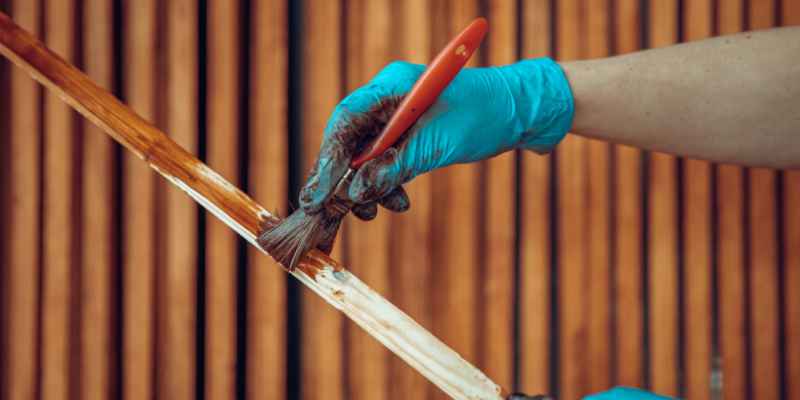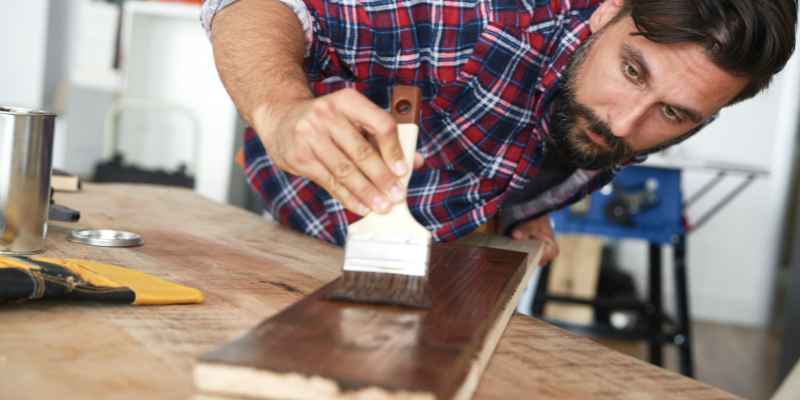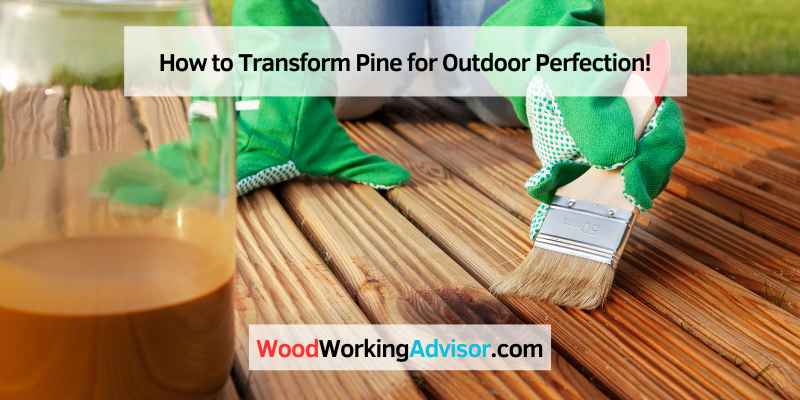To treat pine for outdoor use, apply a sealant or preservative that protects against moisture and UV damage. Preserve the wood’s natural appearance with a clear or tinted finish or enhance its durability with paint.
When exposed to outdoor elements, pine can deteriorate due to moisture, rot, and UV damage. To ensure its longevity, it is essential to treat pine before using it outdoors. This article explores different methods and products for treating pine to withstand outdoor conditions.
By following these guidelines, you can protect your pine from damage and enjoy its natural beauty for years to come. Whether you choose a sealant, preservative, or finish, treating your pine appropriately will help it thrive outdoors and resist the elements effectively.
Choosing The Right Type Of Pine
Choosing the right type of pine for outdoor use is crucial to ensure its longevity and resistance to weathering. Proper treatment methods can enhance its durability and protect against rot and decay. With careful consideration and treatment, pine can be a reliable and attractive choice for outdoor projects.
Pine is a popular choice for outdoor projects due to its durability and natural beauty. However, not all pine is created equal, and it’s essential to choose the right type of pine for your specific outdoor use. When it comes to selecting the ideal pine variety, several factors need to be considered. Identifying different pine varieties and considering climate and weather conditions are crucial steps in finding the perfect type of pine for your outdoor project.
Identifying Different Pine Varieties
Before delving into the different pine varieties, it’s essential to understand that there are two main categories: softwood and hardwood. Softwood pines, such as white pine and yellow pine, are more common and typically selected for outdoor use due to their strength and resistance to decay. Hardwood pines, like loblolly and longleaf pine, offer greater durability but are less commonly used outdoors. Identifying the type of pine you’re working with will help ensure you choose the right treatment and maintenance methods.
Here are a few popular softwood pine varieties commonly used for outdoor projects:
1. Eastern White Pine: Known for its light color and straight grain, Eastern White Pine is a popular choice for outdoor furniture, decking, and siding. It’s relatively easy to work with and provides good resistance to decay and insects when properly treated.
2. Southern Yellow Pine: This dense and durable pine variety is commonly used for decking, fences, and outdoor structures. Its natural resistance to rot, decay, and insects make it an excellent choice for areas with high moisture levels.
Considering Climate And Weather Conditions
When selecting the right type of pine for outdoor use, it’s crucial to consider the climate and weather conditions in your area. Different pine varieties have varying levels of natural resistance to weather-related issues such as moisture, UV exposure, and temperature fluctuations. Here’s a quick overview:
| Pine Variety | Best Suited for | Considerations |
|---|---|---|
| Eastern White Pine | Temperate climates | Avoids extreme temperatures and high humidity |
| Southern Yellow Pine | Moisture-rich environments | Resistant to rot, decay, and insect damage |
Choosing a pine variety that aligns with your area’s specific climate and weather conditions will enhance its durability and longevity. However, regardless of the pine you choose, proper treatment and maintenance, such as applying appropriate finishes, sealants, and regular cleaning, are vital to ensuring its longevity when exposed to the elements.
Remember, identifying the different pine varieties and considering climate and weather conditions are crucial steps in choosing the right type of pine for your outdoor project. By doing so, you’ll be able to enjoy a durable and beautiful outdoor space for years to come.

Preparing Pine For Outdoor Use
Preparing pine for outdoor use is essential to increase its durability and protect it from rot and insects. By taking the necessary steps to treat and protect the wood, you can ensure that your pine furniture, decks, or other outdoor projects will withstand the elements and retain their beauty for years to come.
Debarking And Removing Sap
Before treating pine for outdoor use, it is important to debark the wood and remove any sap or resin. Debarking the pine involves stripping the outer bark from the log or lumber, which not only improves the appearance but also helps prevent insects from burrowing into the wood.
- Debarking can be done using a drawknife or a debarking tool to carefully peel off the bark.
- Removing sap or resin from the pine is crucial to maintain the quality of the wood and prevent it from attracting insects. This can be done by using mineral spirits or a commercial pine sap remover.
- Apply the solvent to a clean cloth and rub it onto the sap or resin until it loosens and can be wiped away.
- After removing the sap, clean the wood surface with a mild soap and water solution and allow it to dry thoroughly before proceeding with further treatment.
Treating Pine To Resist Rot And Insects
To protect pine wood from rot and insects, treatment is necessary. There are various methods and products available for treating pine, including:
- Wood Preservatives: Applying a wood preservative, such as a copper-based solution, can help to protect the pine from rot and insect damage. Follow the manufacturer’s instructions for application, ensuring complete coverage of the wood surface.
- Water Repellents: Applying a water repellent to the treated pine can help to prevent moisture absorption and minimize the risk of rot. Select a water repellent specifically designed for outdoor use and follow the application instructions for best results.
- Sealants or Stains: Adding a sealant or stain to the treated pine not only enhances its appearance but also provides an extra layer of protection against moisture and UV damage. Choose a high-quality sealant or stain suitable for outdoor use and apply it according to the manufacturer’s guidelines.
Remember to reapply wood preservatives, water repellents, and sealants periodically to maintain the protective barrier and extend the lifespan of your outdoor pine projects. Regular maintenance and care will help to keep your treated pine looking beautiful and lasting for years to come.
Sealing And Staining Techniques
Learn effective sealing and staining techniques to treat pine for outdoor use. Enhance durability and protect against weathering for long-lasting outdoor furniture and projects.
Applying A Protective Sealer
One of the crucial steps in treating pine for outdoor use is applying a protective sealer. Sealing the wood helps to prevent moisture penetration, rotting, and warping. It also acts as a barrier against the harmful effects of UV rays and other weather elements.
When applying a sealer, make sure the surface is clean and dry. Begin by lightly sanding the wood to ensure a smooth finish. Then, using a brush or sprayer, evenly apply a coat of the sealer. Allow it to dry according to the manufacturer’s instructions.
For optimum protection, it is recommended to apply multiple coats of the sealer, with sanding in between each layer. This helps to build a stronger barrier and extends the lifespan of the pine. Be sure to check the product label for the recommended number of coats and drying times.
Enhancing The Aesthetics With Stains
In addition to protecting the wood, stains can also enhance the aesthetics of pine for outdoor use. Stains come in a variety of colors and finishes, allowing you to customize the appearance of your outdoor furniture, decking, or other pine projects.
Before applying a stain, it is important to prepare the wood by thoroughly cleaning and sanding it. This helps to remove any dirt, debris, or imperfections, ensuring a smooth and even application. You can use a stain brush, roller, or sprayer to coat the wood, making sure to follow the direction of the grain.
Once the stain has been applied, allow it to penetrate the wood for the recommended amount of time. This allows the color to fully develop and provide a rich, vibrant finish. To protect the stained wood, apply a clear topcoat or sealer once the stain is completely dry.
Designing And Assembling Outdoor Pine Structures
When it comes to creating durable and long-lasting outdoor pine structures, careful design and proper assembly techniques are essential. Whether you’re looking to build furniture, decks, or patios, understanding the process of treating pine wood for outdoor use is crucial to ensure its longevity and resistance to weathering. In this article, we will explore the steps involved in designing and assembling outdoor pine structures to help you create sturdy and beautiful additions to your outdoor living space.
Creating Durable Pine Furniture
Designing and building pine furniture that can withstand outdoor conditions requires attention to detail and the right treatment methods. Here are some key points to consider:
- Choose the right type of pine: Selecting a durable pine species, such as Southern Yellow Pine or Western Red Cedar, can significantly enhance the longevity of your furniture.
- Treat the wood: Applying a weather-resistant finish or sealer to the pine furniture helps protect it from moisture, UV rays, and insect damage. Regular maintenance, including cleaning and refinishing, is also essential to prolong its life.
- Consider the design: Opt for furniture designs that minimize water retention, such as slatted surfaces for tables or chairs with drain holes to prevent standing water accumulation.
Constructing Pine Decks And Patios
Building a pine deck or patio requires careful planning to ensure its durability and resistance to outdoor elements. Here are some important considerations for constructing pine decks and patios:
- Choose pressure-treated pine: Pressure-treated pine, infused with preservatives, offers enhanced durability and resistance to rot, decay, and insect infestation.
- Properly space and secure the boards: Leave sufficient gaps between the deck or patio boards to allow for expansion and contraction due to changes in temperature and humidity. Secure the boards with stainless steel screws or galvanized nails to minimize the risk of rusting or corrosion.
- Apply a protective sealant: After construction, applying a high-quality sealant specifically designed for pressure-treated wood helps protect the pine from moisture and UV damage. Regular maintenance, including cleaning and resealing, will extend the life of the deck or patio.
By following these guidelines for creating durable pine furniture and constructing pine decks and patios, you can ensure your outdoor pine structures withstand the test of time. Remember to choose the right type of pine, treat the wood properly, and consider the design elements that contribute to longevity. With proper care and maintenance, your outdoor pine structures can provide years of enjoyment and enhance the beauty of your outdoor living space.

Maintaining Outdoor Pine
To properly treat pine for outdoor use, follow these steps: clean the wood thoroughly, apply a protective sealant, regularly maintain and reapply the sealant, keep the wood dry and well-ventilated, and avoid exposure to harsh weather conditions. With proper care, your outdoor pine furniture or structures can last for years to come.
Regular Cleaning And Inspection
To ensure the longevity and beauty of your outdoor pine furniture or structures, regular cleaning and inspection are essential. Without proper maintenance, natural elements like sunlight, rain, and dirt can lead to damage and deterioration over time.
Here are some simple steps you can follow to keep your outdoor pine looking its best:
- Start by removing any loose dirt or debris with a soft brush or broom.
- Prepare a gentle cleaning solution using mild soap or dishwashing liquid diluted in warm water.
- Using a sponge or soft cloth, carefully scrub the surface of the pine, paying attention to any areas with stubborn stains or mold.
- Rinse the pine thoroughly with clean water and allow it to dry completely before applying any finishes or sealants.
In addition to regular cleaning, it is important to inspect your outdoor pine for any signs of damage or wear. Look for cracks, splits, or splinters in the wood, as well as any loose or missing fasteners. Addressing these issues promptly can prevent further damage and ensure the structural integrity of your outdoor pine.
Refinishing And Repairs
Over time, outdoor pine may lose its natural color and begin to look dull or weathered. To restore its beauty and protect it from further damage, refinishing is a great option.
Here’s how you can refinish your outdoor pine:
- Sand the surface of the pine using a fine-grit sandpaper to remove any existing finish or rough spots.
- Clean the pine with a mild detergent and water to remove any dust or debris.
- Apply a suitable wood stain or preservative using a brush, roller, or sprayer, following the manufacturer’s instructions.
- Allow the stain or preservative to dry completely before applying additional coats if necessary.
- Finish the refinishing process by applying a protective sealant or varnish to provide extra durability and weather resistance.
If your outdoor pine furniture or structures have suffered significant damage, repairs may be needed. Whether it’s replacing a broken board or reinforcing a weak joint, addressing these issues promptly will help prolong the life of your outdoor pine.
Remember, consistent maintenance and care are key to ensuring the long-lasting beauty and functionality of your outdoor pine. By following these simple steps, you can enjoy your outdoor pine for years to come.
Conclusion
Overall, treating pine for outdoor use is essential in order to prolong its lifespan and protect it from the damaging effects of weather and insects. By following the appropriate steps, such as applying a sealant or stain and regularly maintaining the wood through cleaning and reapplication, you can ensure that your pine furniture or structures remain in great condition for years to come.
Remember, proper treatment not only enhances the appearance but also adds durability. So, invest the time and effort in treating your pine wood, and enjoy its beauty and functionality for many seasons.


